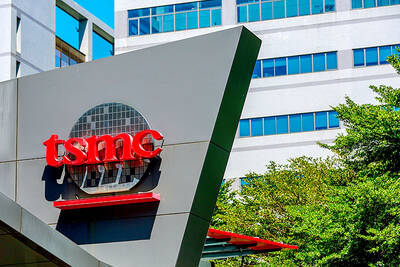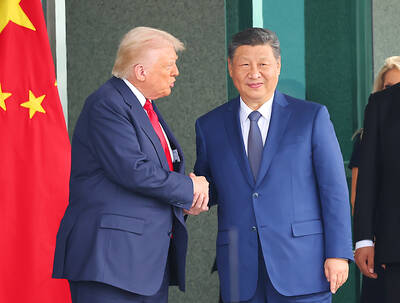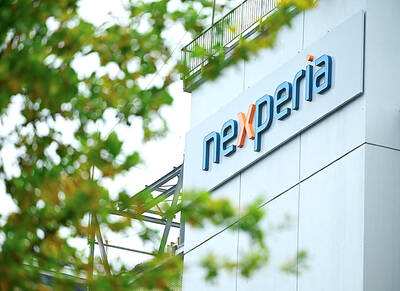The Financial Supervisory Commission (FSC) and the Kaohsiung City Government yesterday jointly hosted a plaque unveiling ceremony for a trial asset management zone in the city as a symbol of the central government’s push to develop Taiwan into an Asian asset management hub.
FSC Chairman Peng Jin-lung (彭金隆) and Kaohsiung Mayor Chen Chi-mai (陳其邁), as well as representatives of 48 financial institutions, attended the ceremony at Asia New Bay Area (亞洲新灣區), the commission said in a statement.
To promote asset management, Peng in a speech touted the significant success that measures and strategies implemented by the commission have had, the statement said.

Photo: CNA
They included the easing of 28 regulations and deregulation of private banking over the past year, while the number of banks approved to launch wealth management programs for high-net-worth clients has increased to 18, Peng said.
The establishment of a trial asset management zone in Kaohsiung is even more indicative of the government’s regional asset management hub development plans, he added.
Twenty-three financial institutions — 14 banks, six securities investment trust companies and three insurance companies — have obtained permission to conduct pilot operations in the zone, the statement said.
The Kaohsiung City Government has provided administrative incentives, including rent discounts and other subsidies, and administrative assistance, while the FSC has deployed policy instruments to incentivize financial institutions to establish operation units within the zone, the statement said.
The commission is studying the next phase of pilot projects to be allowed in the zone, it said.
That includes expanding the scope of cross-border financial services to retaining local wealth onshore while attracting more funds from abroad, and constructing an offshore asset management platform by integrating banking, securities and insurance businesses to provide one-stop financial services for international customers, it said.
The FSC in September last year unveiled the plan to develop an Asian asset management center with Taiwanese characteristics and selected Kaohsiung as the first site for the plan’s pilot operations.
The Kaohsiung City Government since then has signed memorandums of understanding with 54 financial institutions to operate in the zone, the commission said.
Taiwan is leveraging the “Trillion NT Dollar Investment National Development Plan,” unveiled by the National Development Council in December last year, and the FSC’s asset management hub initiative to help attract funds from domestic and foreign investors into the country’s public infrastructure and industrial development, Premier Cho Jung-tai (卓榮泰) said on Tuesday last week.

RUN IT BACK: A succesful first project working with hyperscalers to design chips encouraged MediaTek to start a second project, aiming to hit stride in 2028 MediaTek Inc (聯發科), the world’s biggest smartphone chip supplier, yesterday said it is engaging a second hyperscaler to help design artificial intelligence (AI) accelerators used in data centers following a similar project expected to generate revenue streams soon. The first AI accelerator project is to bring in US$1 billion revenue next year and several billion US dollars more in 2027, MediaTek chief executive officer Rick Tsai (蔡力行) told a virtual investor conference yesterday. The second AI accelerator project is expected to contribute to revenue beginning in 2028, Tsai said. MediaTek yesterday raised its revenue forecast for the global AI accelerator used

Taiwan Semiconductor Manufacturing Co (TSMC, 台積電) has secured three construction permits for its plan to build a state-of-the-art A14 wafer fab in Taichung, and is likely to start construction soon, the Central Taiwan Science Park Bureau said yesterday. Speaking with CNA, Wang Chun-chieh (王俊傑), deputy director general of the science park bureau, said the world’s largest contract chipmaker has received three construction permits — one to build a fab to roll out sophisticated chips, another to build a central utility plant to provide water and electricity for the facility and the other to build three office buildings. With the three permits, TSMC

TEMPORARY TRUCE: China has made concessions to ease rare earth trade controls, among others, while Washington holds fire on a 100% tariff on all Chinese goods China is effectively suspending implementation of additional export controls on rare earth metals and terminating investigations targeting US companies in the semiconductor supply chain, the White House announced. The White House on Saturday issued a fact sheet outlining some details of the trade pact agreed to earlier in the week by US President Donald Trump and Chinese President Xi Jinping (習近平) that aimed to ease tensions between the world’s two largest economies. Under the deal, China is to issue general licenses valid for exports of rare earths, gallium, germanium, antimony and graphite “for the benefit of US end users and their suppliers

Dutch chipmaker Nexperia BV’s China unit yesterday said that it had established sufficient inventories of finished goods and works-in-progress, and that its supply chain remained secure and stable after its parent halted wafer supplies. The Dutch company suspended supplies of wafers to its Chinese assembly plant a week ago, calling it “a direct consequence of the local management’s recent failure to comply with the agreed contractual payment terms,” Reuters reported on Friday last week. Its China unit called Nexperia’s suspension “unilateral” and “extremely irresponsible,” adding that the Dutch parent’s claim about contractual payment was “misleading and highly deceptive,” according to a statement